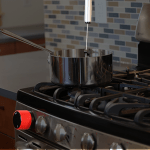 Designers know typography influences the way we view a product. Whether the typeface reflects price, style or age – it’s an important part of branding.
Designers know typography influences the way we view a product. Whether the typeface reflects price, style or age – it’s an important part of branding.
But typography can do more than change a perception – it can change taste.
This is what we discovered at Sarah Hyndman’s wine and type tasting evening, which is running as part of the London Design Festival. I went along to its opening night and discovered the power typography had over the taste of wine.
More than simply creating an excuse for weeknight drinking, Sarah’s using wine was a clever example chosen to show a product controlled by image. It’s an alcohol riddled with pretentiousness. There are so many variants on whether you will have an enjoyable experience – the label, the positioning and price of it on a restaurant menu, the aroma, colour and where it was made.
Sarah believes typography can influence these variants. She’s been involved in research into our psychological responses to the appearance of words with the Crossmodal Research Lab at the University of Oxford, and plans to publish her new book – How to Draw Type and Influence People – in April next year. Before that, she ran her own design company for ten years.
She says the words we read will intensify both our anticipation and enjoyment of a flavour, and the way these words look can do the same thing.
Typeface can make a wine look and taste expensive
If we think a bottle of wine is more expensive, then we will enjoy the taste of it more than if we think it’s cheap. This was the first lesson I learnt.
We were given the task of ordering several typefaces used for wine labels from most expensive to least.
We found labels with thin, smaller-sized, contrasting typefaces (possibly with serifs) were associated with expensive wine. In contrast, jagged, fat typefaces usually don’t go down so well. Looking at these typefaces felt uneasy, like rough edges.

Remember the backlash to the London Olympics design?

Consumer testing of food packaging shows whilst triangular shapes are eye-catching, they’re not the products we tend to buy.
Sarah says this can be traced back to basic human hunter-gatherer instincts.
“Jagged shapes put our brain on alert for potential danger, which could be something sharp or the taste of food that might not be good to eat such as sour or unripe fruit, or bitterness and potentially poisonous,” she says.
“In my opinion it’s a clever manipulation by our own brains to keep us safe.
“However I think that as human beings we like a challenge, we like the sourness of lemons or the bitterness of coffee, and it would be great for us as designers to reflect this more with the typefaces styles we use.”
It’s not manipulation, it’s subconscious
But it’s not just typography itself that influences taste. With design its best to use as many sense as possible to create an experience.
Without revealing all the exercises from the evening, I discovered that drinking the same wine whilst processing separate typefaces, colours, textures and sounds meant the wine shifted from tasting sweet to tasting bitter.
Masculine, earthy tones and rough shapes caused a bitter flavour in the wine to intensify. Feminine, soft and cursive tones accentuated the sweeter and floral flavours.
A good example of this can be seen in the labels of Coca-Cola and Sprite – one sweet, one citrus.
![]()
Even drinking wine while blocking your noise made a difference to the taste of acidity.
But Sarah insists it’s not manipulation but something that happens on an instinctive level – “we’re just not consciously paying attention to it”.
Old World wine vs New World wine typography
An example of different uses in typography can be seen in the labels of Old World wine (France, Italy) and New World wine (Australia, South America, New Zealand).

Old Wine labels use traditional, busier typeface styles and design that link to history and authenticity. This becomes a visual metaphor for what we assume will be the experience of drinking the wine.
The labels feature traditional serif typefaces and formal script. Imagery is often engraved in style and can feature crests or symbols of provenance. Colours are muted, with traditional shades and textures. See the Pinot Noir of France below.
New Wine labels are essentially more entrepreneurial and representative of the modern technology used to make the wine. Contemporary, uncluttered labels aim to appeal to the widest audience possible. See the Pinot Noir of Chile label below.
Imagery is often modern illustrative or photographic. Colours may be brighter, with unusual textures, finishes or shapes.

So what’s the best typeface to use?
Sarah says there’s no magic formula to picking a successful typeface – it has to be a beautiful combination of conveying the right message, tone, context and appropriate size and colour.
“For example if you would like a product to look more expensive then using a well-designed typeface with contrast, possibly serifs, at a smaller size, in a more minimalist design style, and in muted colour tones will convey this. Look at typefaces such as FS Sienna or Didot,” she says.
“If you would like to intensify the sweet and bold flavours then bold and curvaceous typefaces such as Bodoni Poster Italic or Cooper Black should do this, using in lots of ripe red shades.”
Do You Judge a Wine by its Label? will run from 7:30-9:30pm on September 22 and 27 for £30. Sign up here.
You can purchase Sarah’s current book, Why Fonts Matter, from Amazon for £11.89.
[“source-ndtv”]








